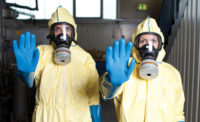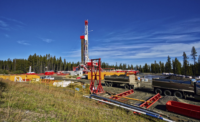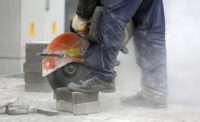Although U.S. OSHA updated its occupational silica standard in 2016 for the first time in 45 years, relatively few countries have followed suit. Aside from a handful of European countries, some Canadian Provinces and Mexico, most other countries do not have as stringent of a standard as the current U.S. Permissible Exposure Limit of 0.05 mg/. In fact, most low and middle-income countries have no regulatory limits for respirable crystalline silica in the workplace.
Globally, occupational exposure standards for silica vary considerably and few have been updated to account for the current scientific evidence linking exposures to disease. In addition, to the risks for silicosis, lung cancer and autoimmune diseases (e.g. Scleroderma), silica dust exposures are significant risk factor for Tuberculosis (TB). Given the much greater prevalence of TB in low and middle-income countries, there is a much greater health risk that is under appreciated and not being addressed by current regulatory mechanisms. The United Nations General Assembly recently acknowledged this need at its first ever meeting on TB declaring that governments should commit to “preventing TB by implementing primary prevention in high-risk occupations by reducing silica dust exposures in mining, construction and other dusty workplaces.”
To better assess the need for new or updated occupational exposures limits, we examined the requirements in 34 countries, and found that 30 of them have specific standards for quartz and sometimes additional forms of crystalline silica (e.g. cristobalite). Table 1 provides a summary of the exposure limits for quartz indicating an average limit of 0.1 mg/and range from 0.025 - 0.3 mg/. Note that these standards are generally based on a time-weighted average for an 8 hour work day. Although the European Union has the ability to set occupational exposure limits as indicative or binding limit values, to date they have not and values are set by each country. Finland, Italy, and Mexico have an equivalent standard to the US. Several Canadian Provinces including British Columbia have, like Portugal, a respirable crystalline silica standard of 0.025mg/m³. At least four countries have a formula-based exposure limit determined by the concentration of crystalline silica in the respirable dust and/or total dust (See Table 2).
In the process of updating its standard, U.S. OSHA conducted an assessment of the risk to workers exposed at its older limit of 0.1 mg/m3. The agency concluded that “employees exposed to respirable crystalline silica are at significant risk of developing silicosis and other non-malignant respiratory disease, lung cancer, kidney effects, and immune system effects.” (Occupational Exposure to Respirable Crystalline Silica; Final Rule; Federal Register; Vol. 81, No. 58; Friday, March 25, 2016) It is well documented that the average occupational exposure limit for crystalline silica (quartz) of 0.1 mg/m3 for the countries listed in Table 1, is inadequate to protect workers against silicosis or the carcinogenic effects of crystalline silica. The American Conference of Governmental Industrial Hygienists (ACGIH) has called for the reduction of exposure limits for crystalline silica to 0.025 mg/m3.
In general, occupational exposure limits are intended not be exceeded when averaged over an eight-hour workday but sometimes the regulations reference an aspirational goal of reducing exposures to levels that are as low as reasonably practicable. However, in some countries exceeding these airborne exposure limits trigger specific workplace requirements including medical surveillance, worker training, respiratory protection, exposure controls (e.g. ventilation and specialized work practices) and ongoing air monitoring. Table 3 summarizes workplace requirements for Australia, Brazil, British Columbia, Canada, China, India, Russia, South Africa, the United Kingdom and the United States. One notable similarity between these countries is that all of them require medical surveillance when workers are exposed to silica above these limits. Worker training is required in Australia, British Columbia, China, the United Kingdom and the United States. Respiratory protection, is required in British Columbia, Russia, the United Kingdom and the United States. Exposure controls are required in Brazil, British Columbia, Russia, the United Kingdom and the United States.
In addition, in some countries including the U.S. there is requirement that all products containing more than 0.1% crystalline silica (by weight or volume) must have cancer warnings. Some European countries that classify crystalline silica as a carcinogen may also have labeling requirements (e.g. Netherlands).
Table 1: Occupational Exposure Limits for Respirable Silica
|
Country |
Silica Quartz (mg/m3) |
|
Australia |
0.1 |
|
Austria |
0.15 |
|
Belgium |
0.1[1] |
|
British Columbia |
0.025 |
|
Bulgaria |
0.07 |
|
Czech Republic |
0.1 |
|
Denmark |
0.1[1] |
|
Estonia |
0.1[1] |
|
Finland |
0.05 |
|
France |
0.1[1] |
|
Greece |
0.1[1] |
|
Hungary |
0.15[2] |
|
Ireland |
0.1 |
|
Italy |
0.05 |
|
Lithuania |
0.1[1] |
|
Luxembourg |
0.15 |
|
Mexico |
0.025 |
|
Netherlands |
0.075 |
|
Norway |
0.1[1] |
|
Poland |
0.3 |
|
Portugal |
0.025 |
|
Romania |
0.1[1] |
|
Slovakia |
0.1 |
|
Slovenia |
0.15 |
|
South Africa |
0.1 |
|
Spain |
0.1[3] |
|
Sweden |
0.1[1] |
|
Switzerland |
0.15 |
|
United Kingdom |
0.1 |
|
United States |
0.05 |
|
Average |
0.1 |
[1] Limit for Christobalite and Tridymite is 0.05
[2] Limit for Christobalite is .1 and Tridymite is .15
[3] Limit for Christobalite is 0.05
Table 2: Other Occupational Exposure Limits for Respirable and/or Total Silica
|
Country |
Silica Quartz (mg/m3) |
|
Brazil |
8.0 mg/m3 respirable dust ÷ (% crystallized free silica +2) AND 24 mg/m3 total dust ÷ (% crystallized free silica + 3) |
|
China |
for free SiO2 >10%/< 50% = 1.0 mg/m3 (total) and 0.70 mg/m3 (respirable) If >50%/<80% free SiO2 = 0.70 mg/m3 (total) and 0.30 respirable If >80% free SiO2 = 0.50 mg/m3 (total); 0.20 (respirable) |
|
India |
10 mg/m3 ÷ % respirable quartz+2 |
|
Russia |
If crystalline SiO2 is >2% < 10% = 4.0 mg/m3 If SiO2 >10%/<60% = 2.0 mg/m3 If SiO2 >60% SiO2 = 1.0 mg/m3 |
Table 3: Regulatory Requirements Linked to Occupational Exposure Standards for Respirable Silica
|
Country |
Training |
Medical Surveillance |
Respiratory Protection |
Exposure Controls |
Air Monitoring |
|
Australia |
✔ |
✔ |
- |
- |
✔ |
|
Brazil |
- |
✔ |
- |
✔ |
✔ |
|
British Columbia, Canada |
✔ |
✔ |
✔ |
✔ |
- |
|
China |
✔ |
✔ |
- |
- |
✔ |
|
India |
- |
✔ |
- |
- |
✔ |
|
Russia |
- |
✔ |
✔ |
✔ |
- |
|
South Africa |
- |
✔ |
- |
- |
- |
|
United States |
✔ |
✔ |
✔ |
✔ |
✔ |
|
United Kingdom |
✔ |
✔ |
✔ |
✔ |
✔ |



